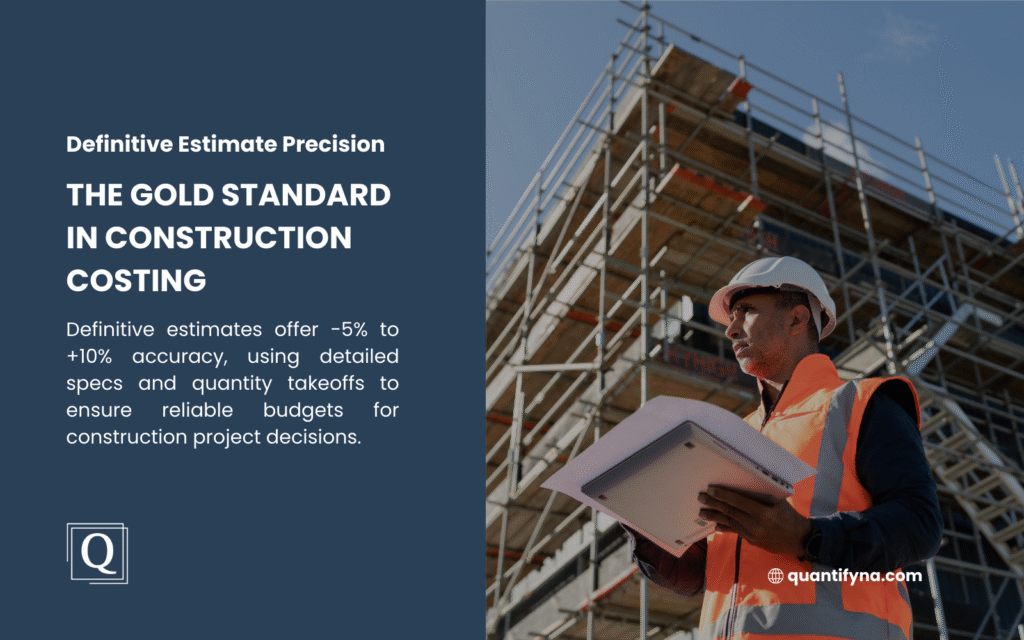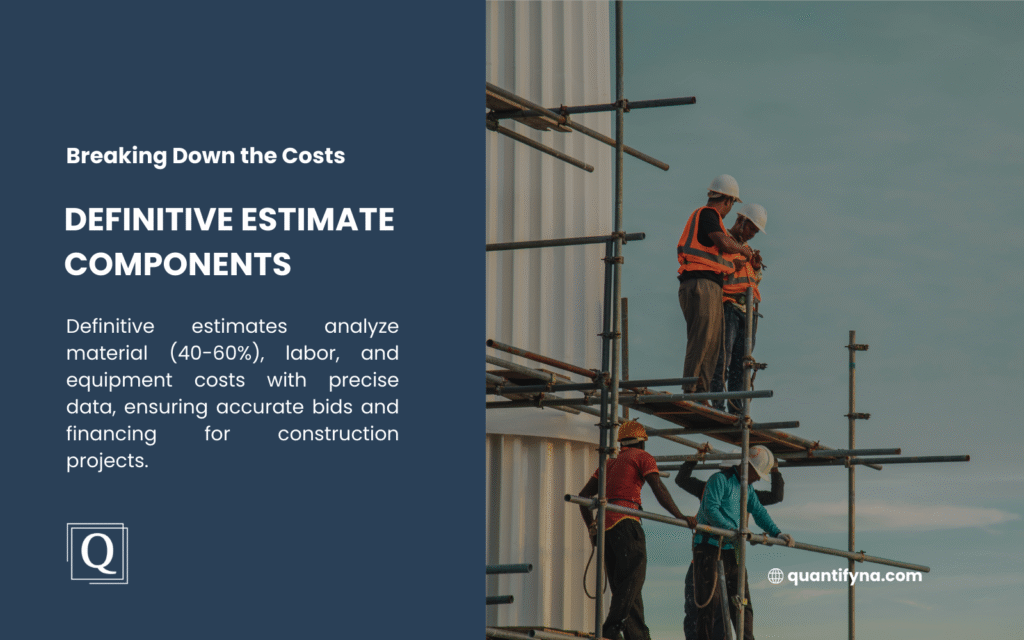This comprehensive guide explores the critical aspects of definitive estimate development in construction projects. Key topics covered include accuracy expectations, preparation methods, cost breakdown structures, and implementation strategies. Readers will discover the difference between rough order of magnitude estimates and definitive estimates, learn about the delphi method application in cost estimation, and gain practical insights into creating reliable project budgets that stakeholders can trust for final decision-making.
What is a Definitive Estimate?
A definitive estimate represents the most accurate and detailed cost projection available for a construction project. Unlike preliminary estimates or rough order of magnitude calculations, this estimate type provides precise cost figures based on complete project documentation, detailed specifications, and thorough quantity takeoffs. Construction professionals rely on definitive estimates to secure final project approval, establish contract values, and make critical business decisions.

The accuracy level of a definitive estimate typically ranges from -5% to +10% of actual project costs. This precision makes it the gold standard for construction cost estimation, particularly when contractors need to submit competitive bids or when owners require reliable budget figures for project financing.
| Estimate Type | Accuracy Range | Project Phase | Documentation Required |
| Rough Order of Magnitude | -50% to +100% | Conceptual | Basic scope definition |
| Budget Estimate | -20% to +30% | Schematic Design | Preliminary drawings |
| Definitive Estimate | -5% to +10% | Design Development | Complete specifications |
| Control Estimate | -3% to +5% | Construction Documents | Final drawings and specs |
Key Components of a Definitive Estimate
Professional estimators develop definitive estimates through systematic analysis of multiple cost elements. Each component requires detailed examination to achieve the accuracy levels that define this estimate type.
Material Cost Analysis
Material costs typically represent 40-60% of total project expenses in construction work. Definitive estimate preparation demands current pricing from suppliers, accurate quantity calculations, and provisions for waste factors. Estimators must account for material escalation, delivery costs, and storage requirements to maintain estimate reliability.
| Material Category | Typical Waste Factor | Price Volatility | Lead Time Impact |
| Concrete | 5-10% | Moderate | Low |
| Steel | 3-5% | High | Medium |
| Lumber | 10-15% | Very High | Medium |
| Flooring Materials | 8-12% | Low | Low |
| Drywall Products | 5-8% | Low | Low |
Labor Cost Calculations
Labor expenses require careful analysis of crew productivity rates, wage scales, and project-specific conditions. Definitive estimates incorporate actual productivity data rather than handbook values, accounting for site conditions, worker skill levels, and project complexity factors.
Specialty trades like flooring installation and drywall work demand particular attention to productivity variations. Regional labor rates, union requirements, and overtime considerations significantly impact final cost projections.
Equipment and Tool Costs
Construction equipment represents a substantial cost component that definitive estimates must address comprehensively. This includes owned equipment depreciation, rental rates, fuel consumption, maintenance expenses, and operator costs.
| Equipment Type | Daily Rate Range | Fuel Cost Factor | Maintenance Factor |
| Excavator (Mid-size) | $400-600 | 15-20% | 10-15% |
| Concrete Pump | $800-1200 | 8-12% | 12-18% |
| Scaffolding System | $50-100 | N/A | 5-8% |
| Drywall Lift | $75-125 | 5% | 8-12% |
Methods for Developing Definitive Estimates
Several proven methodologies support definitive estimate development. Each approach offers specific advantages depending on project characteristics, available data, and timeline constraints.
Bottom-Up Estimation Approach
The bottom-up estimating method builds cost projections from detailed work breakdown structures. Estimators calculate costs for individual work items, and then aggregate these figures to determine total project expenses. This approach provides the highest accuracy levels but requires complete project documentation and significant time investment.
Professional construction estimating firms like Quantify North America utilize bottom-up methods for complex commercial projects where accuracy requirements justify the detailed analysis effort.
Parametric Estimation Techniques
Parametric estimating applies statistical relationships between project variables and costs. This method uses historical data to establish cost-per-unit relationships, such as cost per square foot for flooring projects or cost per linear foot for drywall installation.
| Project Type | Parametric Unit | Typical Range | Accuracy Level |
| Office Flooring | Cost per SF | $8-25 | ±12% |
| Drywall Installation | Cost per SF | $2.50-4.50 | ±10% |
| Interior Painting | Cost per SF | $1.50-3.50 | ±15% |
| Ceiling Systems | Cost per SF | $6-18 | ±12% |
Expert Judgment Integration
The Delphi method represents a structured approach to incorporating expert judgment into definitive estimates. This technique gathers input from multiple estimating professionals, processes their opinions through iterative rounds, and develops consensus cost projections.
Construction firms often combine expert judgment with quantitative analysis to address estimate uncertainties and validate cost projections. This hybrid approach proves particularly valuable for specialized work where historical data may be limited.
Accuracy Factors in Definitive Estimates
Multiple variables influence the accuracy of definitive estimates. Project estimators must address these factors systematically to achieve target precision levels.
Documentation Quality
Complete and accurate project documentation forms the foundation of reliable definitive estimates. This includes architectural drawings, specifications, soil reports, and regulatory requirements. Missing or incomplete information directly correlates with estimate accuracy degradation.
| Documentation Level | Estimate Accuracy | Risk Level | Decision Confidence |
| 100% Complete | ±5-8% | Low | High |
| 90% Complete | ±8-12% | Medium | Medium |
| 80% Complete | ±12-18% | High | Low |
| 70% Complete | ±18-25% | Very High | Very Low |
Market Conditions
Current market conditions significantly impact definitive estimate accuracy. Material price volatility, labor availability, and subcontractor capacity all affect final project costs. Estimators must incorporate current market intelligence and trend analysis into their cost projections.

Project Complexity Factors
Complex projects present additional challenges for definitive estimate development. Factors such as site access limitations, phasing requirements, and coordination complexities can substantially impact costs beyond standard work item pricing.
Common Applications of Definitive Estimates
Construction professionals utilize definitive estimates across various project phases and decision points. Each application demands specific accuracy requirements and documentation standards.
Contract Bidding
Competitive bidding situations require highly accurate definitive estimates to balance winning probability with profit margins. Contractors must account for all project costs while maintaining competitive pricing positions.
Specialty contractors focus on specific work types, such as painting estimates or drywall takeoffs, where detailed knowledge of trade-specific factors supports accurate cost projections.
Project Financing
Financial institutions and project owners rely on definitive estimates for loan approvals and investment decisions. The accuracy and credibility of these estimates directly impact project financing terms and approval likelihood.
| Financing Type | Required Accuracy | Documentation Level | Review Process |
| Construction Loan | ±5-8% | Complete | Extensive |
| Investment Decision | ±8-10% | Detailed | Moderate |
| Budget Approval | ±10-12% | Standard | Basic |
| Preliminary Planning | ±15-20% | Limited | Minimal |
Change Order Management
Definitive estimates support change order evaluation by providing baseline cost data for comparison purposes. When project modifications occur, estimators can reference original definitive estimate components to calculate fair pricing for additional work.
Technology Tools for Definitive Estimation
Modern construction estimating relies heavily on specialized software and technology platforms. These tools enhance accuracy while reducing preparation time for complex definitive estimates.
Estimating Software Platforms
Professional estimating software automates quantity calculations, maintains current pricing databases, and facilitates estimate documentation. Popular platforms include PlanSwift, MeasureSquare, and specialized trade software for flooring, drywall, and painting work.
Digital Takeoff Tools
Digital takeoff technology allows estimators to measure quantities directly from electronic drawings. This approach reduces measurement errors while providing audit trails for estimate verification purposes.
| Software Category | Primary Function | Accuracy Benefit | Time Savings |
| General Estimating | Cost compilation | 15-20% | 30-40% |
| Digital Takeoff | Quantity measurement | 20-25% | 40-50% |
| Trade-Specific | Specialized calculations | 25-30% | 50-60% |
| Database Integration | Current pricing | 10-15% | 20-30% |
Best Practices for Definitive Estimate Development
Successful definitive estimate preparation follows established industry practices that maximize accuracy while maintaining cost-effectiveness in the estimation process.
Systematic Review Processes
Multiple review stages help identify potential errors and omissions before estimate finalization. This includes internal peer review, client consultation, and third-party validation when appropriate.
Historical Data Integration
Construction firms maintain databases of actual project costs to support future definitive estimate development. This historical information provides reality checks for current estimates and helps identify cost trends over time.
Risk Assessment Integration
Definitive estimates should incorporate appropriate contingency allowances based on project-specific risk factors. This includes market risks, technical risks, and schedule risks that could impact final project costs.
| Risk Category | Typical Contingency | Assessment Method | Management Strategy |
| Market Volatility | 3-8% | Price trend analysis | Fixed-price contracts |
| Technical Complexity | 5-12% | Expert evaluation | Design clarification |
| Schedule Pressure | 2-6% | Timeline analysis | Resource planning |
| Regulatory Changes | 1-4% | Code review | Compliance monitoring |
Quality Control in Definitive Estimates
Comprehensive quality control processes separate professional definitive estimates from basic cost calculations. These procedures validate estimate accuracy and completeness before client delivery.
Peer Review Systems
Independent review by qualified estimators helps identify calculation errors, missed items, and questionable assumptions. This process significantly improves final estimate reliability and client confidence.
Benchmarking Analysis
Comparing definitive estimates against similar completed projects provides validation of cost projections. Building estimation professionals maintain extensive databases for this comparison purpose.
Client Verification Processes
Collaborative estimate review with clients helps identify scope clarifications and ensures estimate alignment with project expectations. This process reduces disputes and change orders during project execution.
Cost Management Through Definitive Estimates
Definitive estimates serve as cost control baselines throughout project execution. Regular comparison between actual costs and estimate projections enables proactive cost management.
Budget Monitoring Systems
Project teams track actual expenses against definitive estimate line items to identify cost variances early in the construction process. This enables corrective action before significant overruns occur.
Value Engineering Opportunities
Detailed definitive estimates reveal opportunities for cost reduction through design modifications or construction method changes. Teams can evaluate alternatives against baseline estimates to quantify potential savings.
| Value Engineering Focus | Typical Savings | Implementation Effort | Risk Level |
| Material Substitution | 5-15% | Low | Low |
| Construction Methods | 8-20% | Medium | Medium |
| Design Simplification | 10-25% | High | High |
| Schedule Optimization | 3-12% | Medium | Low |
Professional Services for Definitive Estimates
Many construction firms outsource construction estimating to specialized service providers who offer expertise in definitive estimate development. These services provide access to experienced estimators, current pricing data, and specialized software tools.
Service Provider Selection
Choosing qualified estimating services requires evaluation of experience, accuracy track records, and specialty knowledge in relevant construction trades. Providers should demonstrate consistent achievement of definitive estimate accuracy targets.
Cost-Benefit Analysis
Estimate costs for professional services must be weighed against potential benefits including improved accuracy, reduced internal workload, and faster estimate delivery. Many firms find that outsourced definitive estimates provide positive returns on investment.
Ready to develop accurate definitive estimates for your next construction project? Quantify North America specializes in precise cost estimation for flooring, drywall, and painting projects. Our experienced team delivers the accuracy and reliability your project demands. Contact us today to discuss your estimation needs and discover how professional estimating services can improve your project outcomes.
Key Takeaways
Definitive estimates represent the highest accuracy level in construction cost estimation, typically achieving -5% to +10% precision when properly developed. Success requires complete project documentation, systematic cost analysis, and professional expertise in trade-specific factors. Modern technology tools enhance accuracy while reducing preparation time, making definitive estimates accessible for projects of all sizes. Quality control processes and peer review systems ensure estimated reliability before client delivery. Professional estimating services provide access to specialized expertise and current market data, often delivering superior results compared to internal estimation efforts.




